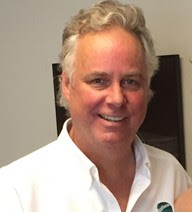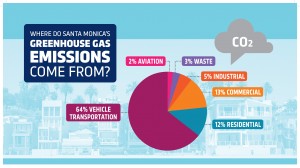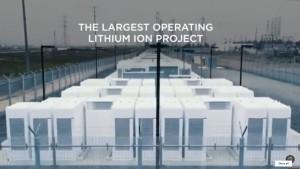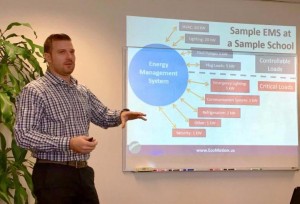February 24, 2017 – Volume 19 #2: The “End of Drought”
In This Issue
Flanigan’s Eco-Logic
The Green Sports Alliance
Cities Heading to 100% Renewable Power
Tesla PowerPacks to the SoCal Rescue!
Clean Energy Jobs Dwarf Dirty Ones
Energy Efficiency and Demand Response Programs Savings
What’s Up at EcoMotion?

Flanigan‘s Eco-Logic: California’s Water Future
Steady rains in Southern California this week fuel a fire in me. It’s painful to watch all this fresh water run out to the sea. The channeled Los Angeles River is like a water luge… chuting millions of gallons of desperately needed potable water out to sea.
I cringe at the thought of our region’s most limited natural resource – freshwater – be disposed of as an effluent. We conserve water daily – in our showers, toilets, sprinklers, car washes, etc. – and now just look at this macro water waste. One expert estimates that 163 billion gallons of fresh water slips through our water channels and to the sea each year, enough to fill a swimming pool for every home in America.
According to a January 2017 report by the Public Policy Institute of California, “Water management in California has always been challenging. The state’s variable climate is marked by long droughts and severe floods, with stark regional differences in water availability and demand.” The state has built a massive network of storage and water conveyance systems to cope with this. But population growth and climate change exacerbate the challenge of matching water supply and demand.
In 2015, the California State Assembly formed the special Select Committee on Water Consumption and Alternative Sources. The Committee, in its final report, concluded that the state must undertake proactive measures – beyond conservation – to adjust to hotter climates and limited water sources.
Think of California’s water future. Many areas of the state are predicted to have a drier and drier climate. SoCal may well be parched, with more severe heat days and less water on tap. And yet our population grows. Where will our water come from? How much more conservation can be supplied? How about greywater recycling? Some say look west, to the Pacific Ocean. Poseidon and other firms are promoting desalinization. We have plenty of water… you just have to take the salt out.
My eyes return to the river. Yes, if we could only capture this rainwater that is chugging through our city, down massive storm channels, and store it in tanks, in reservoirs. Think how beneficial that amount of water would be.
Just as there is an energy storage revolution in the power sector, California’s water future also may be all about storage, at scales from the household level, to acres of spreading ponds for groundwater recharge. I love the work of TreePeople here in LA, storing water through a combination of urban forestry and community collection cisterns for storm water management. Andy Lipkis and his team there have been promoting a suite of storm water management tools: permeable surface, bioswales, cisterns, rain barrels, and infiltration basins that seep water in the aquifers below. The San Gabriel Coastal Spreading Grounds in Pico Rivera is 700 acres of land acquired to trap water after LA’s deadly flood of 1938. It’s a great model, capturing hundreds of millions of gallons of water a year before it runs to the sea. These works need to be scaled and replicated.
A massive storage scheme may well serve California, better than importing water. Water pipelines have been considered for California, and negotiated in preliminary form with a former Governor of Alaska, Wally Hickel. The plan was to build four, 14 foot in diameter, 1,400-mile pipelines from the mouth of either the Copper River or Stikine River in Alaska, to move 1.3 trillion gallons a year south to California. Analysts considered the $110 billion project as magnificent and complex, in an engineering sense, as the Panama Canal, the Trans Alaskan oil pipeline, even the Chunnel. Some advocated pulling an Arctic iceberg south to LA. A few winters ago, some considered trucking snow from Boston over the Rockies to the West. These ideas all do seem crazy now as torrents of rainwater run to the sea in rapids.
But now – thanks to the record rains and snowpack — the impetus for long-term water planning may be over here in California, at least dampened. December was a record wet month. The snowpack in the Sierras is exceptional. Mammoth Mountain is getting too much snow to keep ski operations open. Reservoirs are full and now spilling water. The Governor has lifted water restrictions. And experts agree that the surface water drought is largely over. Most Californians now assume that we are out of the woods.
Yes, 2016 was exceptional in terms of precipitation. What a relief! But will the drought end in 2017? If the winter rains are decent, experts believe, the north will be in pretty good shape. But experts also point out that it will take several wet years for the south to recover, and significantly overdrawn groundwater basins in the Central Valley may take decades to come back. During droughts, farmers rely heavily on groundwater to make up for reduced surface-water supplies. In turn, many small, poor rural communities have lost drinking water supplies as their wells have gone dry.
So good news: We’re trending in the right direction. The “cup” is certainly more full than empty, but California’s water woes are not over. Much of Southern California is still in extreme drought. LA’s rain is not washing away this problem. The Golden State needs to keep a clear eye on the future and to keep developing water supply and management systems that can sustain us all in a time of climate change.
Quote of the Week
“Year-after-year, renewables are proving themselves to be the energy sources making America great again.”
– Ken Bossong, SunDay Campaign
The Green Sports Alliance
 This past Sunday I experienced both the thrill and substance of the National Hockey League, going to its All-Star Game at Staples, and having brunch with Allen Hershkowitz, co-founder and president, of the Green Sports Alliance; Omar Mitchell, the NHL’s VP for Corporate Social Responsibility; and my best bud Michael Totten who consults for the NHL. I’d really never thought about how influential a league can be… from cancer awareness to promoting health and exercise, to planting trees, working with Habitat etc.
This past Sunday I experienced both the thrill and substance of the National Hockey League, going to its All-Star Game at Staples, and having brunch with Allen Hershkowitz, co-founder and president, of the Green Sports Alliance; Omar Mitchell, the NHL’s VP for Corporate Social Responsibility; and my best bud Michael Totten who consults for the NHL. I’d really never thought about how influential a league can be… from cancer awareness to promoting health and exercise, to planting trees, working with Habitat etc.
We were joined by Joel Reynolds, Natural Resource Defense Council’s western director. He took on the U.S. Navy whose sonar was impacting Pacific sea life from dolphins to whales. A book was written about his extraordinary environmental victory called War of the Whales. He tells us that he’s sold off his living rights. His passion has been reducing underwater noise pollution that affects ocean wildlife.
Our group was struck by the energy at the game. Hey, it was only an All-Star Game, and wow, how the fans carried on! How can we get the public similarly interested in global and local sustainability? Dream on! Great defensemen from Drew Doughty to Bobby Orr were in the building… not to mention Wayne Gretsky!
The Green Sports Alliance was formed in February 2010 “to leverage the cultural and market influence of sports to promote healthy, sustainable communities where we live and play.” GSA was conceived and founded by the Seattle Seahawks, Portland Trail Blazers, Vancouver Canucks, and Natural Resources Defense Council. It was originally supported by the Bonneville Environmental Foundation, Green Building Services, and Milepost Consulting.
Today, GSA’s members total 379, including 177 teams, 187 venues, 15 leagues, hailing from 14 countries. GSA inspires sports leagues, teams, venues their partners, and their millions of fans, to exchange information about best practices and to develop solutions to environmental problems.
Omar Mitchell talked of his role at the NHL, particular promoting sustainability. Many NHL member arenas have taken bold steps. They are big power users, using lots of refrigeration for perfect game ice. Now Omar and the NHL are looking at how GSA might influence the efficiency and sustainability of the ~4,800 community rinks across the country and in Canada. GSA is also focused on China, a vast market apparently “intrigued” by hockey… the world’s fastest sport.
Cities Heading to 100% Renewable Power
This past week, my EcoMotion colleagues Michael Ware and Drew Lowell-Britt headed to the Santa Monica Annenburg Beach House for a Climate Action Plan (CAP) meeting, a meeting of the minds. Three cheers: The City’s 15×15 CAP exceeded its own goals. Instead of achieving reductions of 15% below 1990 levels in municipal operations and community wide, the City has achieved a 20% reduction. Now it is headed to net zero.
 So, how can any city, in this case Santa Monica, go from 20% below 1990 levels to zero carbon? The power sector is greening on its own and with marked results. Transport accounts for 64% of the City’s current footprint. EVs – battery and hydrogen fuel-cell powered EVs – have the potential to cut that carbon. Will we have enough “spill-over” renewables – having fully satisfied our demand for electricity – that we can power our transportation sector?
So, how can any city, in this case Santa Monica, go from 20% below 1990 levels to zero carbon? The power sector is greening on its own and with marked results. Transport accounts for 64% of the City’s current footprint. EVs – battery and hydrogen fuel-cell powered EVs – have the potential to cut that carbon. Will we have enough “spill-over” renewables – having fully satisfied our demand for electricity – that we can power our transportation sector?
This issue also arose for water and space heating in Santa Monica. Will we have enough “extra” renewable power for additional purposes? Traditionally, direct combustion of a fuel is more thermodynamically efficient than using electricity. But now, with an electrified society, electric water heat pumps, electric cooktops, and electric heating systems make sense as next steps in the quest for carbon zero. The Stone Edge Farm in Sonoma, an experimental microgrid, is fully powering its facilities and now electrolyzing water to create hydrogen fuel for one of its vehicles.
Imagine a city, your city, powered exclusively by renewable resources. It will likely have to be a mix of renewables. This diversity addresses intermittency. The sun shines during the day, wind in the interior of our nation blows at night. Coastal states’ wind farms provide power in the mornings and evenings, power shifting due to coastal and desert temperature differentials. Other renewables operate like baseload power plants, they can run all the time, or can be “ramped” up and down as needed. These include geothermal hydro plants, methane-fueled microturbines, and biomass plants.
Imagine no more coal, and no more natural gas or nuclear either. To be in the “100% club” you have to pledge to get it all from renewables. And guess what? Already, nearly 100 cities around the world have made the pledge, including San Francisco, San Diego, San Jose, Rochester, Minnesota, and more. Many plan to do so by 2035. All hope to do so at zero marginal cost… at parity with current power prices.
Some cities have already done it! Burlington, Vermont has been given lots of notoriety for its 100% renewable power generation and use. Its wood chip plant provides its base load power; then it has solar, wind, and hydro. Aspen, Colorado also achieved the 100% goal in 2015 with its own hydro plant providing 50% of its generation.
In the fall of 2016, the City of Los Angeles City Council passed a resolution for its municipal utility – LADWP – to study the path to 100% renewable by 2035. Consider the magnitude of the task: Each year Los Angeles Department of Water and Power sells about 25,000 GWh of power. Currently, 20% of that, or 5,000 GWh, is renewable. By 2020, 33% of the power will be renewable. Right now, 40% is coal-fired, 22% is natural gas, and 9% is nuclear. Together with maximizing energy efficiency, the City will have to completely replace these sources with a mix of power that fulfills demand 24/7.
One of the tools that will help cities get to 100% cost-effectively is energy storage. Storage provides a means to buy cheap power at night – say wind from the Midwest – and to use it during peak periods. The City of Los Angeles has a 1.6 GW pumped storage system that can provide 20% of system capacity for up to six hours. Envision doubling this so that LA becomes the nation’s storage capitol, able to tap the lowest-cost renewables for peak power use. These storage systems can also provide “ancillary services” to the grid, stabilizing the frequency… as resources change and as consumption changes.
To transform a city of four million people – like Los Angeles – with major buildings, industries, oil refineries, airports, etc. – to 100% renewable will be herculean. It will require participation in energy efficiency initiatives the likes of which we have never seen before, with retrofits that get deep penetration. I propose a city that is 20% more efficient. We propose solar generation to be ubiquitous on our rooftops, over parking lots, on building facades; even north-facing rooftops! Storage will be embedded in our garages, in our communities, and at utility power plants and substations. And also powering our city will be renewables in our deserts, from states afar, and potentially offshore.
Tesla Powerpacks to the SoCal Rescue!
 Tesla claims it’s the biggest in the world using lithium-ion batteries… a 20 MW/80 MWh Powerpack energy storage facility at Southern California Edison’s Mira Loma substation in Ontario, California, about 40 miles east of Los Angeles.
Tesla claims it’s the biggest in the world using lithium-ion batteries… a 20 MW/80 MWh Powerpack energy storage facility at Southern California Edison’s Mira Loma substation in Ontario, California, about 40 miles east of Los Angeles.
The project was announced in September, 2016 in response to Edison’s concern about peak power given the rupture of the Aliso Canyon natural gas storage field and Governor Jerry Brown’s proclamation of a state of emergency. Edison was charged with finding and streamlining the development of new sources of peak capacity. As such, Edison will charge the batteries at night and discharge them during peak power periods.
The system took three months from manufacture in Sparks, Nevada to interconnection. Installed are 396 of Tesla’s new Powerpack 2, each the size of a refrigerator, and each containing 16,000 lithium-ion battery cells. The Powerpack 2 has twice the power of the first Powerpack (210 kWh vs. 100 kWh). The Mira Loma project also features the first use of Tesla’s own inverter, increasing efficiency. The system can provide the equivalent storage of several hundred acres of solar panels.
In fact, three storage plants – built by Tesla, AES and Altagas — are going live in Southern California. They account for 15% of all batteries installed planet-wide last year. Yes, the action is hot! Prices for lithium-ion batteries have fallen in half since 2014 largely driven by the economic of scale necessary to meet EV demand. Bloomberg New Energy Finance shows that in 2013 batteries cost $599/kWh. Now in 2016, the same batteries sell for $273/kWh. So far, Tesla Energy, formed in 2015, has shipped 300 MWh of batteries to 18 countries.
Could this spell the end of the gas peaker? Bloomberg says that batteries have just reached a critical mass for widespread deployment in power systems worldwide. They address current peak power concerns, as well as “the duck curve.” California is on track to have an overabundance of renewable energy during the day, supply that drops sharply as the sun sets, causing a sharp rise in demand after dusk. Batteries can be placed in service quickly without need for water and fuel supply conduits and infrastructure, avoiding the need for long environmental reviews and permitting processes. Thus batteries are taking the place of natural gas peaking plants… able to capture and use the carbon-free, renewable power.
Clean Energy Jobs Dwarf Dirty Ones

Workers at Westmont Solar Project
The U.S. Department of Energy reports that renewable energy firms are creating more jobs than their fossil fuel counterparts. In fact, solar and wind energy companies generated more jobs than oil, coal, and natural gas combined… even though renewables provide a fraction of the power of their fossil predecessors. Solar energy, for example, provides only 1.3% of the nation’s power, but creates twice as many jobs as coal that provides 30% of the nation’s power.
The entire supply chain of solar and wind industries including those that manufacture, install, and run turbines and panels employs 476,000 workers, while fossil fuel companies employ 187,117 people.
The solar industry is adding jobs at a rate 17 times faster than the overall U.S. economy. One in 50 new jobs in the U.S. was in the solar industry. According to Vote Solar, and drawing from The Solar Foundation’s Solar Jobs Census, 260,000 people are working in the solar industry, another year of double-digit growth. American solar industry created one new job every 10 minutes. California is the nation’s leader with over 100,000 workers. California solar jobs grew by 32% in 2016.
Combined newly installed capacity from renewable resources biomass, geothermal, hydro, solar, and wind totaled 16,124 MW in 2016, surpassing that of natural gas (8,689 MW), nuclear (1,250 MW), oil (58 MW), and coal (45 MW). For the second year in a row, the majority of the nation’s new capacity is renewable.
Energy Efficiency and Demand Response Programs Savings

For more than 20 years, the American Council for an Energy Efficient Economy (ACEEE) has been tracking the energy savings from utility-sector energy efficiency programs. In 2015, nationally, these programs saved about 200 billion kWh, more than 5% of retail electric sales. In some leading states, these programs exceed 10% of retail electric sales… and could reach 20% by 2020.
The ACEEE report also finds that for the top energy efficiency program administrators, demand response savings are about 66% of their energy savings. Thus a utility that achieves a 15% savings from energy efficiency programs will cut its peak demand by about 10%.
Meanwhile, The Natural Resources Defense Council recently published a report on pay-for-performance (P4P) energy efficiency programs in the U.S. in which the Metrus ESA – Energy Savings Agreement — was highlighted as a nationwide solution. If America is going to meet its GHG reduction goals, utilities will need to treat energy efficiency as the demand-side resource that it is and implement creative pay for performance models. Rather than promoting efficiency and sustainable behavior with an endless stream of rebates and other incentives, Metrus and others have developed the ESA which charges consumers for saved kWh just as PPA charge consumers for generated kWh. For more information on the ESA model, see EcoMotion’s White Paper on ESAs.
What’s Up at EcoMotion?

- All LA Metro solar systems now repaired and monitored
- Conducted three solar trainings for Metro facilities professionals
- Completed Westmont solar project video
- Prepared cost-effectiveness studies for solar ordinance for the cities of Santa Monica and Palm Springs
- Completed White Paper on Ancillary Services
- Completed White Paper on Creating Microgrids
- Developed Carbon-Free Microgrids Presentation
- Continue to facilitate comprehensive school lighting and HVAC retrofits
- Helped two charter schools get solar systems at no cost
- We’re creating 12 carbon-free microgrids for power outage protection
- Developed concept of PERCs – Powered Emergency Response Centers
- Welcome new clients:
- Los Angeles Leadership Academy
- LeFiell Manufacturing
- Gorman Learning Center
- Capistrano Connections Academy
